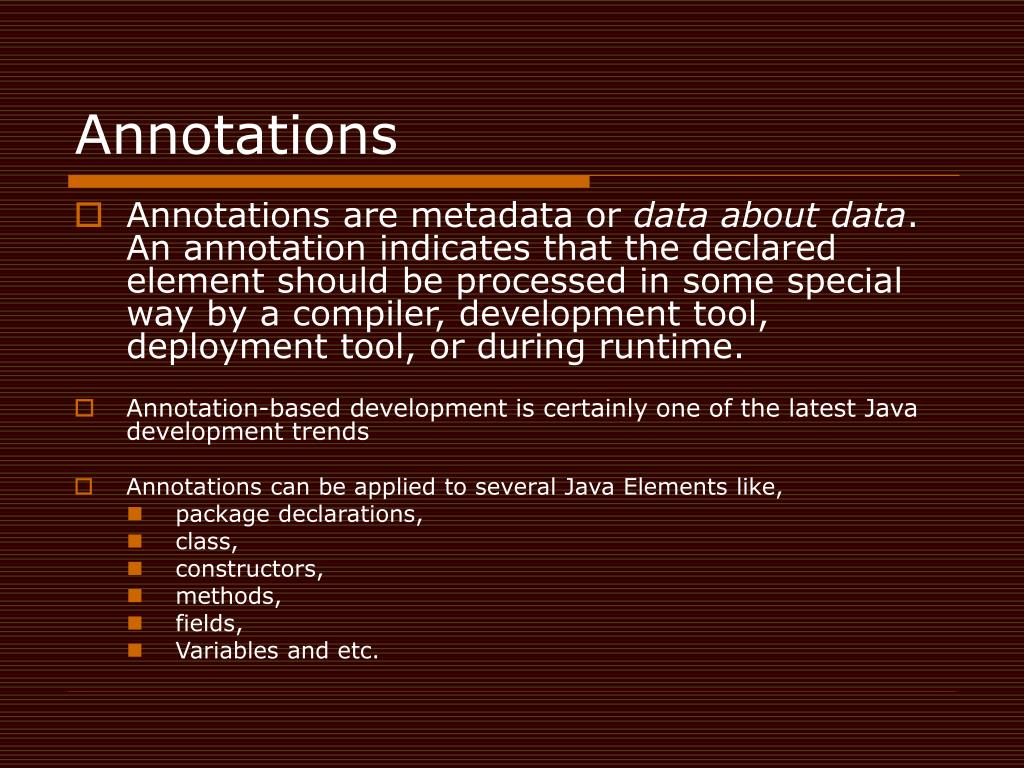

When used upon a class, the attributes are applied for all the methods in that class. This annotation can be used on Classes and Methods. ApmRootTracker - Can be used upon the methods which are likely to be starting point of transaction execution (background).ApmTracker - Can be used upon any classes and methods, which will be instrumented and included in the traces.Java agent API library provides two annotations which can be used in your application to track the performance of your custom classes and methods.Make sure the jar file is exported along with the application's libraries. Include the apminsight-javaagent-api.jar file to the project build path.
#JAVA ANNOTATIONS DOWNLOAD#
Download the apminsight-javaagent.zip file which includes agent jar with its associated files along with the apminsight-javaagent-api.jar.Usage of Java annotation enables you to define custom names for the transaction and also assign a custom component. Using Java annotations, APM Insight provides an easier way to custom instrument your application classes and methods. Filer: Like the name suggests with Filer you can create files.Custom Instrumentation using Java Annotations.Types: A utils class to work with TypeMirror (more information later).Elements: A utils class to work with Element classes (more information later).Handy, isn’t it? In getSupportedAnnotationTypes() we specify that is processed by this processor. We can use annotation processors in our annotation processor.

This AutoService annotation processor has been developed by Google and generates the META-INF/services/ file. In the first line you see What’s that? It’s an annotation from another annotation processor. Package com.example public class MyProcessor extends AbstractProcessor Every Processor extends from AbstractProcessor as follows: The generated java file will be compiled by javac as any other hand written java source file. So you can not manipulate an existing Java class for instance adding a method.
#JAVA ANNOTATIONS CODE#
What does that exactly means? You can generate Java code! The generated java code is in a generated. So it has become popular in the last few years.Īn annotation processor for a certain annotation takes java code (or compiled byte code) as input and generate files (usually. It took some time until the java world realized the power of annotation processing. Annotation processing is already available since Java 5 but a useable API is available since Java 6 (released in December 2006). If you are not familar with annotations you can find more information in the official java documentation.
#JAVA ANNOTATIONS HOW TO#
At this point I assume that you already know what an annotation is and how to declare an annotation type. You can register your own annotation processor for certain annotations. Annotation processing takes place at compile time (compile time = the time when the java compiler compiles your java source code).Īnnotation processing is a tool build in javac for scanning and processing annotations at compile time. To clarify a very important thing from the very beginning: we are not talking about evaluating annotations by using reflections at runtime (run time = the time when the application runs). In a second step we will implement a simple annotation processor step by step. First, I am going to explain to you what annotation processing is, what you can do with that powerful tool and finally what you cannot do with it. English definition of annotation is footnote/explanation, which means this is a.

In this blog entry I would like to explain how to write an annotation processor. Java Annotations are a kind of meta-data, about elements of your code.


 0 kommentar(er)
0 kommentar(er)
